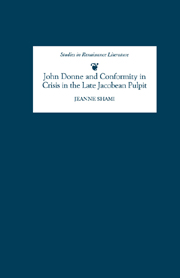Book contents
- Frontmatter
- Contents
- Dedication
- Acknowledgements
- Abbreviations
- 1 “Discreet or religious preachers”: John Donne and the late Jacobean Public Sphere
- 2 “The indiscretion of that foole”: John Knight and the Jacobean Pulpit, 1620–2
- 3 “The fishing of whales”: John Donne's Sermons, 1620–2
- 4 “Faire interpretation”: The Directions and the Crisis of Censorship
- 5 “Wise as Serpents, and innocent as Doves”: Zeal and Discretion in the Pulpit, 1623–5
- 6 “Jesus Wept”: The Journey to Spain and Pulpit Lamentation
- 7 “Blinde buzzards in the choise of a wife”: Sermons and the Moral Marketplace
- 8 “The Lovesick Spouse”: Parliament, Patriots, and the Public Sphere
- 9 “Church-quakes”: Post-Parliamentary Faultlines
- 10 “If the Foundations be Destroyed”: Rules of Engagement
- 11 “Blessed sobriety”: John Donne, the Public Sphere, and Caroline Conformity
- Works Cited
- General Index
- Index to John Donne References
- Index to John Donne's Sermons
- Studies in Renaissance Literature
9 - “Church-quakes”: Post-Parliamentary Faultlines
Published online by Cambridge University Press: 12 September 2012
- Frontmatter
- Contents
- Dedication
- Acknowledgements
- Abbreviations
- 1 “Discreet or religious preachers”: John Donne and the late Jacobean Public Sphere
- 2 “The indiscretion of that foole”: John Knight and the Jacobean Pulpit, 1620–2
- 3 “The fishing of whales”: John Donne's Sermons, 1620–2
- 4 “Faire interpretation”: The Directions and the Crisis of Censorship
- 5 “Wise as Serpents, and innocent as Doves”: Zeal and Discretion in the Pulpit, 1623–5
- 6 “Jesus Wept”: The Journey to Spain and Pulpit Lamentation
- 7 “Blinde buzzards in the choise of a wife”: Sermons and the Moral Marketplace
- 8 “The Lovesick Spouse”: Parliament, Patriots, and the Public Sphere
- 9 “Church-quakes”: Post-Parliamentary Faultlines
- 10 “If the Foundations be Destroyed”: Rules of Engagement
- 11 “Blessed sobriety”: John Donne, the Public Sphere, and Caroline Conformity
- Works Cited
- General Index
- Index to John Donne References
- Index to John Donne's Sermons
- Studies in Renaissance Literature
Summary
BY THE BEGINNING of the summer of 1624, Buckingham had withstood an assault by the Spanish ambassadors during his illness, people were rejoicing in the anti-Spanish turn of English foreign policy, and war with Spain seemed imminent. Parliament had been prorogued until 22 November. The possibility of a marital and military alliance with France to restore the Palatinate and the expectation that more co-operation between king and people would ensue was expressed in sermons and pamphlets by openly warlike and anti-popish rhetoric. Donne's friend James Hay, Earl of Carlisle, had been sent to France to promote the French match, and Buckingham, attended by George Abbot, was about to return to court after an extended illness. John Knight, whose infamous sermon advocating resistance to tyrannical kings had precipitated the Directions, was named chaplain by the Earl of Southampton to his regiment (although he died in prison). Jesuits and recusants were once more officially out of favour, due to the proclamation against Jesuits (6 May) and the Petition on Religion (23 April), which had passed earlier in the parliamentary session.
The situation was ripe for renewed anti-popery, as well as for increased antipuritanism. Preachers and magistrates were charged to exercise the anti-papist sanctions already confirmed by parliament. Others used the opportunity to challenge separatist threats to order in the church, to condemn controversy, and to provoke anti-puritan sentiments.
- Type
- Chapter
- Information
- John Donne and Conformity in Crisis in the Late Jacobean Pulpit , pp. 234 - 255Publisher: Boydell & BrewerPrint publication year: 2003



